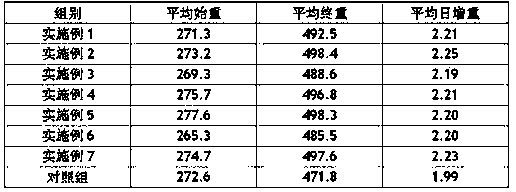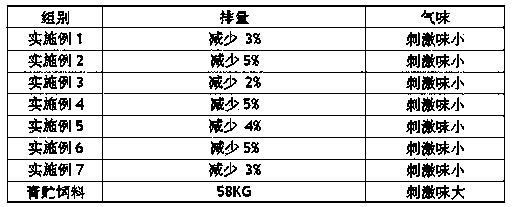Method for producing nisin and lactic acid through simultaneous saccharification and fermentation and application of nisin and lactic acid in feed
A technology of simultaneous saccharification and fermentation and nisin, applied in the field of bioengineering, can solve the problems of high feed cost, easy spoilage of silage, and inability to store for a long time, and achieve the effect of improving feed quality, inhibiting the reproduction of bacteria, and increasing the profit of breeding.
- Summary
- Abstract
- Description
- Claims
- Application Information
AI Technical Summary
Problems solved by technology
Method used
Image
Examples
Embodiment 1
[0028] Get 100ml Erlenmeyer flask, weigh 4% straw respectively and add in the Erlenmeyer flask, then add NaCl 2 g / L, MgSO 4 ·7H 2 O 0 . 2 g / L, yeast extract powder 10 g / L, peptone 10 g / L, CaCO 3 30g / L, then add 2ml pH5 citric acid buffer to the shaker flask and mix well, make up to 27g with deionized water, adjust the pH to 5, seal and weigh for sterilization. After sterilization, place it to dry, weigh it, and calculate the water loss to replenish water. At the same time, add 0.05% Tween-80 to react for 1.5 hours, then add sterilized cellulase 15FPU / g, β-glucosidase 5 IU / g cellulose, Xylanase 5 IU / g cellulose, pectinase 5 IU / g cellulose and shake well, and pre-hydrolyze at 50°C for 3 hours after sealing. After pre-hydrolysis, add 10% inoculum containing lactic acid bacteria to the reaction system Lactococcus lactis subsp. lactis The bacterial solution (OD value 2) was put back in a water bath shaker at 37°C, 160rpm for fermentation, and fermented for 96 hours. After the...
Embodiment 2
[0030] Get 100ml Erlenmeyer flask and weigh 3% straw respectively and add in the Erlenmeyer flask, then add NaCl 2 g / L, MgSO 4 ·7H 2 O 0 . 2 g / L, yeast extract powder 10 g / L, peptone 10 g / L, CaCO 3 50g / L, then add 2ml of pH5 citric acid buffer to the shaker flask and mix well, make up to 27g with deionized water, adjust the pH to 5, seal, weigh and sterilize. After sterilization, place it to dry, weigh it, and calculate the water loss to replenish water. At the same time, add 0.05% Tween-80 to react for 1.5 hours, then add sterilized cellulase 15FPU / g, β-glucosidase 5 IU / g cellulose, Xylanase 5 IU / g cellulose, pectinase 5 IU / g cellulose and shake well, and pre-hydrolyze at 50°C for 3 hours after sealing. After pre-hydrolysis, add 10% inoculum containing lactic acid bacteria to the reaction system Lactococcus lactis subsp. lactisThe bacterial solution (OD value 2) was put back in a water bath shaker at 37°C, 160rpm for fermentation, and fermented for 96 hours. After the f...
Embodiment 3
[0032] Get 100ml Erlenmeyer flask, weigh 4% straw respectively and add in the Erlenmeyer flask, then add NaCl 2 g / L, MgSO 4 ·7H 2 O 0 . 2 g / L, yeast extract powder 10 g / L, peptone 10 g / L, CaCO 3 30g / L, then add 2ml pH5 citric acid buffer to the shaker flask and mix well, make up to 27g with deionized water, adjust the pH to 5, seal and weigh for sterilization. After sterilization, place it to dry, weigh it, and calculate the water loss to replenish water. At the same time, add 0.05% Tween-80 to react for 1.5 hours, then add sterilized cellulase 25FPU / g, β-glucosidase 10 IU / g cellulose, Xylanase 5 IU / g cellulose, pectinase 5 IU / g cellulose and shake well, and pre-hydrolyze at 50°C for 3 hours after sealing. After pre-hydrolysis, add 10% inoculum containing lactic acid bacteria to the reaction system Lactococcus lactis subsp. lactis The bacterial solution (OD value 2) was put back in a water bath shaker at 37°C, 160rpm for fermentation, and fermented for 96 hours. After th...
PUM
 Login to View More
Login to View More Abstract
Description
Claims
Application Information
 Login to View More
Login to View More - R&D
- Intellectual Property
- Life Sciences
- Materials
- Tech Scout
- Unparalleled Data Quality
- Higher Quality Content
- 60% Fewer Hallucinations
Browse by: Latest US Patents, China's latest patents, Technical Efficacy Thesaurus, Application Domain, Technology Topic, Popular Technical Reports.
© 2025 PatSnap. All rights reserved.Legal|Privacy policy|Modern Slavery Act Transparency Statement|Sitemap|About US| Contact US: help@patsnap.com


